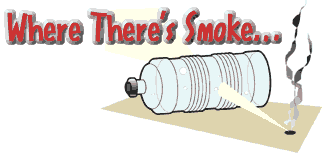 A
special report issued by the Flight Safety Foundation in 1994 noted
that "aircraft fires are rare, but their prospect is terrifying."
When such events do occur, crew and passengers often have only moments
to escape toxic fumes and acrid smoke. (FSF Cabin Crew Safety, Vol.
28, No. 6 and Vol. 29, No. 1).
A
special report issued by the Flight Safety Foundation in 1994 noted
that "aircraft fires are rare, but their prospect is terrifying."
When such events do occur, crew and passengers often have only moments
to escape toxic fumes and acrid smoke. (FSF Cabin Crew Safety, Vol.
28, No. 6 and Vol. 29, No. 1).
Some of the more common causes
of inflight smoke and fumes reported to ASRS are hydraulic fluid leaks
in air conditioning packs, and electrical shorts in cockpit instrumentation.
But several ASRS reports describe highly unusual incidents involving
inflight smoke and suspected fire. We begin with a First Officer whose
thirst had nearly unquenchable consequences.
- While
in level cruise at 11,000 feet, I was enjoying a drink of water from
a clear, plastic water bottle that I normally carry with me on flights.
Suddenly, the Captain and I smelled smoke in the cockpit. About a
second later, I felt an intense burning pain on my left leg. When
I looked down, I found the smoke to be coming from my pants leg. The
cause of this unusual occurrence also became immediately evident --
the clear water bottle that I had resting between my legs had magnified
the sunlight coming through the side window! The beam was concentrated...on
my left leg near the bottle. At least if a fire had actually been
allowed to develop, the emergency procedure would have been quite
simple: 1) pull open spout; 2) squirt!
This event has caused me to think of the possible consequences of
leaving a water bottle or other clear plastic or glass object on a
pilot's seat or console in an unattended aircraft parked outside in
the sun.
Other pilots may wish to
follow our reporter's lead and consider adopting personal procedures
to prevent such "pants on fire" experiences.

The Captain of a twin turboprop
Beech 99 reports that he and his co-pilot followed emergency procedures
to the letter when flames were spotted in the engine louvers during
a cargo flight:
- On a VFR
flight at 7,500 feet MSL, the First Officer reported seeing flames
in the louvers just aft of the inboard engine exhaust on the #2 engine.
I noted the fire T-handle warning light was not on, unstrapped [the
seat belt], and visually confirmed a bright yellow-orange flickering
through the louvers. After strapping back in, I ordered execution
of the "engine fire in flight" checklist. Engine shutdown
and feather were normal.
After completion of the checklist, the First Officer reported the
fire still present. This was disconcerting, since the T-handle (firewall
shutoff valve) had been pulled as part of the checklist. I immediately
turned toward the nearest airport, and was on the verge of declaring
an emergency with Center when the First Officer said, "Wait a
minute, I see some tape fluttering." I asked him to confirm that
he saw no flames, only fluttering tape. This he did. At this point,
we realized that the change in airflow caused by the now feathered
prop and the change in the angle of the sun as a result of the turn
to the field had revealed our engine fire to be a rapidly flickering
piece of orange silicone tape.
We conducted an air restart (carefully monitoring the instruments,
fire warning indicators, and louvers). Restart was uneventful and
we [landed] uneventfully.
Post-flight [inspection] revealed a 3-inch length of loose orange
tape dangling from an orange-insulated line.
 The pilot of a twin-engine General Aviation aircraft
was on an IFR flight plan in instrument conditions when smoke filled
the cockpit. Quick thinking and good resource utilization saved the
day:
The pilot of a twin-engine General Aviation aircraft
was on an IFR flight plan in instrument conditions when smoke filled
the cockpit. Quick thinking and good resource utilization saved the
day:
- Pilot
and front seat passenger smelled [smoke] and shortly after saw smoke
emanating from the instrument panel. I turned off the #2 nav/comm
and found that the smoke ceased. I then pulled the circuit breaker
and opened the vent window to air out the cabin. I advised ATC of
the problem, and requested and received clearance to the departure
airport. I asked the front seat passenger to advise the rest of the
occupants of the situation, to remain calm, and asked him to retrieve
my approach charts. This led to an uneventful landing. I contacted
the Tower and was told no report was required to be filed.
I have learned to keep handy the plate for the approach in use at
the departure airport in the event I ever have to return for landing
during IFR conditions.
As a result of this incident,
the reporter has adopted a procedure -- keeping close at hand the approach
plates for the departure airport -- that is standard for many commercial
operations, and recommended for any pilot flying in actual instrument
conditions.
 A Captain reports to ASRS that he
has adopted a new type of personal checklist following an inflight medical
emergency:
A Captain reports to ASRS that he
has adopted a new type of personal checklist following an inflight medical
emergency:
- En route,
Flight Attendants advised us of a sick passenger in the back. The
flight was diverted to [airport] XYZ to disembark the passenger.
Prior to departure [from XYZ], diversion being a thing that I had
never done before, I discussed with the First Officer if there was
anything else that we needed to do before departure. We couldn't think
of anything so we departed.
On climbout, I realized that we had had a medical emergency and that
the Flight Attendants had used oxygen and the Emergency Medical Kit
(EMK). We called them up and found that they had used one [oxygen]
bottle down to 500 lbs. and a second down to 1,000 lbs. They had also
used the blood pressure cuff from the EMK. At least one oxygen bottle
and the EMK should have been replaced or resealed before departure
from XYZ.
I have since created for myself a "diversion checklist"
to help me to remember what I need to [do] should I have a diversion
again in the future.
If the crew had filled out
the aircraft logbook with a notation regarding the emergency items,
the Emergency Medical Kit and portable oxygen bottles might have been
replenished at the diversion location before the flight continued. This
reporter's company and others might also consider implementing a procedure
for company dispatchers to follow when an aircraft diverts for a medical
emergency. In the meantime, the reporter's idea of a diversion checklist
is a good one.
 A
First Officer's experience with inflight illness underscores the wisdom
of policies in place at many airlines that prohibit flight crews from
eating the same meals during a flight or on layovers.
A
First Officer's experience with inflight illness underscores the wisdom
of policies in place at many airlines that prohibit flight crews from
eating the same meals during a flight or on layovers.
- First
Officer (me) had earlier noticed an upset stomach which he thought
due to an 8-hour-previous spicy lunch he had eaten. Took antacids
and symptoms went away. Takeoff and climb were normal. Approximately
30 minutes into cruise upset stomach returned with nausea. First Officer
went on 100% oxygen and that helped temporarily. A few minutes later,
acute nausea and intense digestive discomfort manifested themselves.
A doctor was summoned and her diagnosis was onset of the flu or other
virus. At that point the First Officer [got sick]....
The Captain and dispatch elected to have us divert to XYZ for a new
First Officer. During the flight, the Captain handled the radios most
of the time...I did PNF duties such as checklists and sometimes ATC/radio
communications. No emergency was declared, although the Captain did
ask for priority [handling]. After a night in the hotel I had no more
nausea, but did have general flu-like symptoms....
I consulted my physician [later]. He diagnosed it as food poisoning,
and after a comprehensive exam said I was well and could return to
flying. Let this be a warning to crews, especially single-pilot crews,
about the severity and suddenness [with which] food poisoning or a
virus can strike.
We hope that all flight crews
will take our reporter's warning to heart, along with the additional
thought that special precautions against food poisoning need to be taken
by those flying overwater routes. Ill crew members cannot easily be
replaced once an aircraft is mid-Pacific or mid-Atlantic.

An air carrier Captain prefaces
his report of a runway incursion by noting, "Follow the Yellow
Brick Road -- or in this case, the inlaid green taxi centerline lights
-- and you may not get to the Emerald City, or to the correct runway
either."
- I called
for a taxi clearance, and was told to taxi to Runway 9 -- no via this
or that taxiway. There was a runway parallel to our track and a somewhat
reassuring string of green lights passing under the nose and strung
out up ahead. Only trouble was, they didn't lead to Runway 9. As I
approached an intersecting runway (12/30), the co-pilot questioned
our taxi route. Prior to his comment, I was thinking all was just
fine. I didn't want to slam on the brakes, and by the time I realized
that he was right, we were across Runway 12/30. Fortunately the runway
was closed.
I've been to this airport dozens of times before. The difference between
going the right way and the wrong way amounted to allowing myself
to follow a few green lights and not being more vigilant in checking
the taxi route. I should have stopped the aircraft at the first hint
of confusion.
The reporter fell into two
traps -- assuming that his aircraft was intended to follow the green
taxi centerline lights, and that they would lead him to the desired
runway. In this instance, one or both of these assumptions turned out
to be incorrect. The First Officer's concern about the taxi route should
have been a heads-up to the crew to contact Ground Control for clarification.


 A
special report issued by the Flight Safety Foundation in 1994 noted
that "aircraft fires are rare, but their prospect is terrifying."
When such events do occur, crew and passengers often have only moments
to escape toxic fumes and acrid smoke. (FSF Cabin Crew Safety, Vol.
28, No. 6 and Vol. 29, No. 1).
A
special report issued by the Flight Safety Foundation in 1994 noted
that "aircraft fires are rare, but their prospect is terrifying."
When such events do occur, crew and passengers often have only moments
to escape toxic fumes and acrid smoke. (FSF Cabin Crew Safety, Vol.
28, No. 6 and Vol. 29, No. 1).![]() The pilot of a twin-engine General Aviation aircraft
was on an IFR flight plan in instrument conditions when smoke filled
the cockpit. Quick thinking and good resource utilization saved the
day:
The pilot of a twin-engine General Aviation aircraft
was on an IFR flight plan in instrument conditions when smoke filled
the cockpit. Quick thinking and good resource utilization saved the
day: A Captain reports to ASRS that he
has adopted a new type of personal checklist following an inflight medical
emergency:
A Captain reports to ASRS that he
has adopted a new type of personal checklist following an inflight medical
emergency: A
First Officer's experience with inflight illness underscores the wisdom
of policies in place at many airlines that prohibit flight crews from
eating the same meals during a flight or on layovers.
A
First Officer's experience with inflight illness underscores the wisdom
of policies in place at many airlines that prohibit flight crews from
eating the same meals during a flight or on layovers.